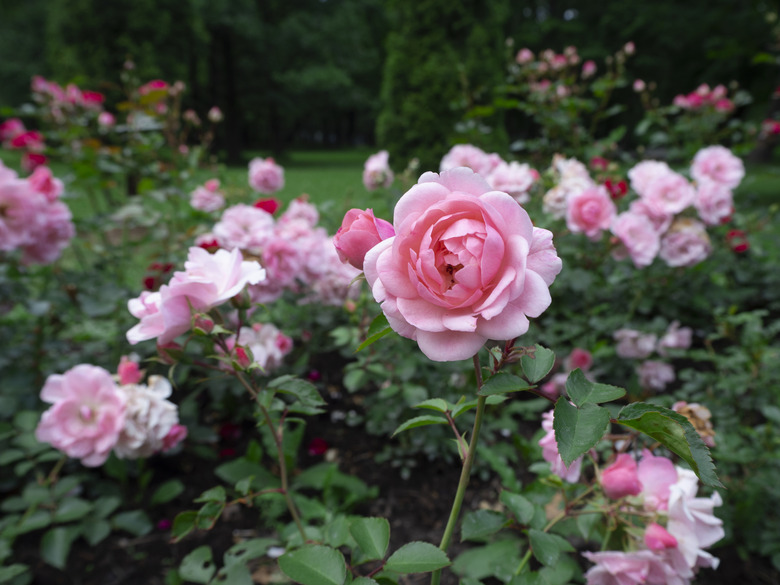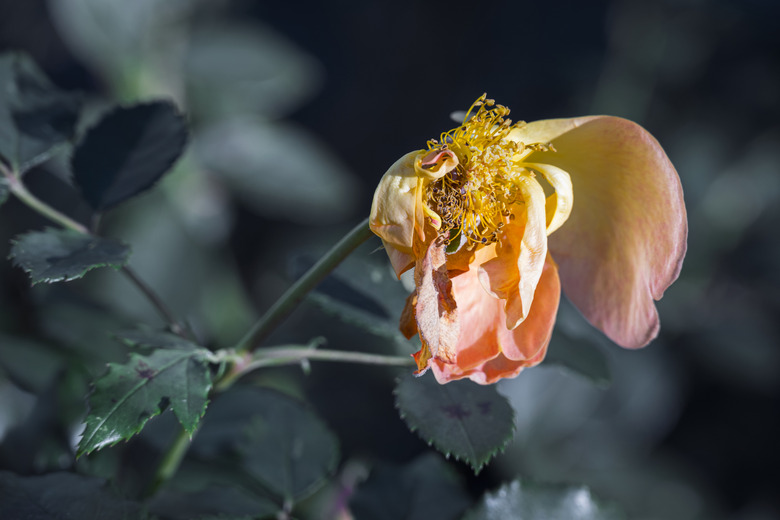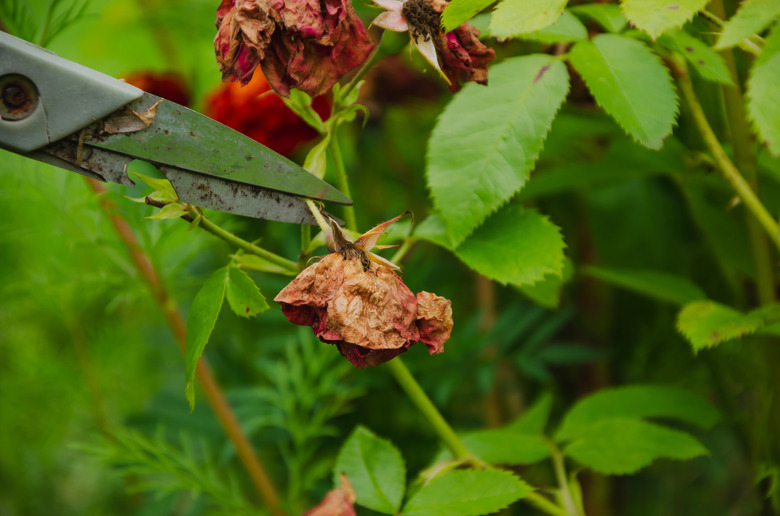How To Save A Dying Rose Bush — And How To Tell If It's Already Dead
We may receive a commission on purchases made from links.
Rose bushes (Rosa spp.) hold a special place in any flower garden, but they also come with their share of problems. This can leave you searching for ways to save a dying rose bush to keep the fragrant blooms and beautiful green foliage thriving. Investigating the cause of the rose bush problems can help you correct the issue before the bush dies completely. Common issues that can threaten your rose bushes include poor cultivation practices, pests, and diseases. Even if your rose bush already looks dead, there's still hope. In most climates, rose plants go dormant over winter, and most look fairly dead by the time spring rolls around. Even if all of a rose's stems, or canes, look dry and black, we have tips on how to tell if a rose is still alive.
How to Save a Dying Rose Bush
How to Save a Dying Rose Bush
Your rose bush may be in declining health because of bad soil conditions, improper watering, diseases, or pests. Examine the bush and its surroundings carefully and then follow these steps to help revive your rose.
A struggling rose bush could be dying due to improper growing conditions. When growing roses, the ideal location has a minimum of six hours of sunlight each day, plenty of space for their roots, and good air circulation. Morning sunlight is ideal because it's not as harsh as afternoon light, and it helps dry rose bush foliage early in the day, reducing the risks of many fungal diseases that thrive in moist conditions.
1. Make Sure It Has Enough Room
If your rose needs more sunlight and breathing room, prune or move plants around it. Moving surrounding plants may mean digging them up and relocating them to a different garden space to let in more sunlight and increase the air circulation around your roses. If surrounding plants are much larger than your roses, you may want to consider digging and moving your roses to a more suitable location. If you've planted roses as foundation plants along an exterior wall, steps, or other structure, bear in mind that these structures prevent air from circulating around your roses. Although some types of roses are suitable as foundation plants, not all of them are, notably those that are more susceptible to fungal diseases such as powdery mildew.
2. Provide Winter Protection
If winter temperatures frequently drop below 20 degrees and your rose bush is planted in an exposed area, provide extra protection when the next winter comes. After the first hard frost, cut back any overly long canes and pile 10 to 12 inches of loose, well-draining soil, leaves, or straw around the plant. You can also tie long canes together instead of pruning them to prevent them from breaking during winter winds.
3. Make Sure the Soil Is Well-Drained
Loose, loamy, rich soil is ideal for a rose garden. Compact or heavy clay soil can make it difficult for the roots to prosper. It can also cause waterlogged soil, which often leads to root rot that can kill your rose bushes.
If your rose bushes are planted on poorly draining soil:
- Try sloping the area around them to improve drainage.
- Then, add 2 or 3 inches of well-rotted manure, compost, leaf mold, or a combination of organic matter around your bush.
Repeated annually, the application of organic matter will eventually improve the soil. If your bush is small enough, consider transplanting it to a more suitable location or digging it up so you can improve the soil: Mix in 1/4 peat moss, compost, or other organic matter with 3/4 native soil and amend the entire planting site instead of just the planting hole. Transplanting roses in early spring before they fully emerge from dormancy typically results in higher success rates for establishing new plants compared to transplanting in hot weather, which further stresses plants.
4. Provide Proper Watering and Mulch
If your rose bush care has been lacking, focus on providing all the care a rose needs to flourish. When your area doesn't receive rain, irrigate your roses twice per week during hot summer weather, soaking the root zone to water the bushes deeply. Provide several inches of mulch around the bush to help conserve moisture between waterings, but be sure to pull mulch away from the canes at least 6 inches in all directions. Frequent shallow watering causes the roses to dry out and might encourage shallow root growth, which can promote heat damage to the roots. Your roses need consistent moisture, but overwatering the soil can increase the risk of diseases and root damage.
5. Prune Regularly
Pruning roses regularly can also help the plants stay healthy. Regular pruning is best done in late winter to early spring for most types of roses. Cut out damaged, diseased, or pest-infested rose branches when you spot them to limit the spread and damage. Always sanitize your pruners by wiping them with alcohol between cuts to prevent the spread of disease.
6. Look for Signs of Pests
Aphids, Japanese beetles, spider mites, thrips, and rose midges are common rose pests that can damage the bushes. You can often see the pests on the plants, especially if you have a major infestation. You can also see holes or distortion in the leaves and flowers where the insects eat them or suck sap from them.
Many rose pests can be removed from the branches with a steady stream of water from your garden hose. Japanese beetles can be picked off the foliage and dropped in a can of soapy water. If possible, avoid using synthetic chemical pesticides, which also kill the beneficial insects that can help control rose pests. Insecticidal soap is safe for most beneficial insects when used according to the label directions and is a less-toxic way to kill many rose pests, including aphids, mites, and thrips.
7. Check for Rose Bush Diseases
Rose diseases can also affect the foliage and blooms. Many rose diseases are caused by excessive moisture, especially moisture on foliage that doesn't have time to dry before night. Keeping your bushes pruned for air circulation and being careful to avoid getting foliage wet can reduce the risk of diseases.
Black spot is a fungal disease revealing itself by black spots on leaves, which eventually turn yellow and fall off. Curled, twisted leaves with a powdery coating on them can be a sign of powdery mildew. Botrytis blight causes a gray fuzzy growth, often on older, dying tissue, such as old flowers. Treatment for most fungal diseases starts by removing and disposing of the affected branches. Fungicide is most effective in preventing many common rose diseases, especially when applied to new growth as it emerges, instead of waiting until disease has taken hold of a plant.
Other diseases have no cure. Crown gall causes growths on the stem at the soil line, which can stunt the rose bush's growth. The viral rose mosaic disease is another incurable disease that causes yellow lines on leaves and may stunt growth or weaken the plant. Rose rosette disease causes irregular growing patterns, such as excessive thorns and deformed and reddish leaves, and can cause the bush to decline. For all of these incurable diseases, removing and destroying the affected bushes to prevent spreading diseases to other plants is the best option.
How to Tell if a Rose Bush Is Dead
How to Tell if a Rose Bush Is Dead
If you're wondering whether you have a dying plant, you're not alone. Roses can be hardy in U.S. Department of Agriculture plant hardiness zones 2 to 11 depending on the species and cultivar, and many survive winter even if parts of them die back. But sometimes, roses don't show signs of life when spring rolls around. Try one of these methods to check whether or not your rose bush is still alive.
1. No Leaves
The simplest way to determine whether a rose is alive or dead is to wait to see if it sprouts green leaves in springtime. Watch the plant carefully to see if leaf buds form along the stems in late winter to early spring. If they do, then you'll know what parts of the plant are dead and what parts are alive. Once you can see swollen leaf buds, begin spring pruning to remove dead wood.
Tip
Sanitize your pruning tools before using them on roses and then again before making each cut. Also sanitize them when you finish pruning. Sanitize tools by wiping the blades with alcohol or soaking them in the alcohol.
2. No Green
If you don't want to wait for leaves to sprout or you haven't noticed signs of the rose's life in spring, then check whether any parts of the rose canes are still alive. First, pull away any winter protection from the base of the plant. Starting midway down a cane, use a sanitized pruning knife to scrape away the outer layer of bark.
If the cane is alive, you'll see a green layer under the bark. If the cane is dead, the inner layer will be brown. If you find a dead area, keep using the knife periodically down the cane until you either find a green layer or reach the base of the plant. If you don't find green on any of the canes, then the rose bush is most likely dead.
3. No Stems Above Graft Union
Even if their upper canes are dead, some roses can come back to life from the roots. This often depends on whether or not the roses are grafted. Some rose bush tops are grafted onto more vigorous rootstocks to provide increased hardiness. Grafted roses include many hybrids, such as Rosa 'Hotel California' (USDA zones 5 to 9). Other roses are grown on their own roots. They include species roses and many old garden roses.
A grafted rose is considered dead if all the stems above the graft union (or the central part where all the canes shoot from) are dead. The rose may still sprout from the roots, but it will not be the same kind of rose bush it was previously. Instead, it will be whatever rose species was used as its rootstock, and it may not even bloom. Roses growing on their own roots, however, can still come back from the roots. Before removing those plants, wait until late spring or early summer to see if they sprout new shoots.


